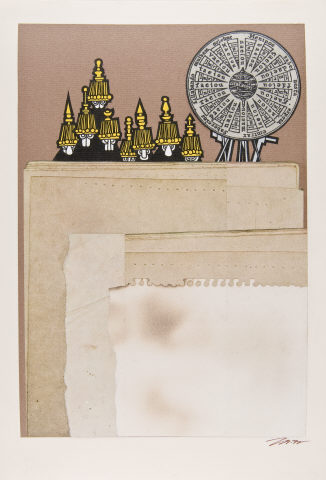
- 1972
- Paper
- Collage, Gouache and Indian ink
- Inv. 83DP1130
João Abel Manta
Quem é este?
This 1972 work belongs to the set of 21 illustrations for José Cardoso Pires’s book Dinossauro Excelentíssimo (Most Excellent Dinosaur) (Lisbon: Arcádia, 1972), in which the writer creates a satirical portrait of the life of António Salazar and the history of the Estado Novo regime.
The illustration is from the first part of the book, titled ‘The Man Who Came from Nothing’, and depicts the episode in which Salazar and his parents – shown as rural people of modest origins – travelto Coimbra, the ‘city of scholars’, where, on their arrival, they encounter an elitist and provincial atmosphere marked by the power of the city’s academic institution.
The composition is divided into two parts. The bottom section contains sheets from a studentnotebook upon which sit eight stylised male figures. Depicted as cardinals of wisdom, of varying sizes and hierarchies, they wear academic dress, with black capes, stoles and hats that resemble ecclesiastical garments, distinguished only by the vertical or spherical geometric forms that top their hats.
In the drawing, our attention is drawn to the top half of the composition, where alongside the figures there is a representation of the so-called ‘reading wheel’ from the Cartilha (ReadingPrimer) by João de Barros (1496-1570), regarded as the world’s first illustrated textbook, and published as part of Barros’s Grammatica da Lingua Portuguesa Com os Mandamentos da Santa Madre Igreja (Grammar of the Portuguese Language With the Commandments of the Holy Mother Church), in 1539-40. The wheel shows a syllabic game, arranged in a circle and divided into sections. At the centre there is an armillary sphere, representing the Portuguese empire, and around the outside there is an inscription in the form of a rhyme: ‘Meninossabeinestaesperaemtrar. Sabereissillabandomuibemsoletrar’ (‘Children this sphere will serve you well. Through syllables you will learn to spell.) Abel Manta thus perfectly depicts the ‘temple’ of scholars, education and the religious and mythical nature of initiation into academic life.
Sandra Vieira Jürgens
May 2015
| Type | Value | Unit | Section |
| Width | 20,8 | cm | |
| Height | 18 | cm | |
| Height | 30,8 | cm | |
| Height | 26,2 | cm |
| Type | signature |
| Type | date |
| Type | Acquisition |